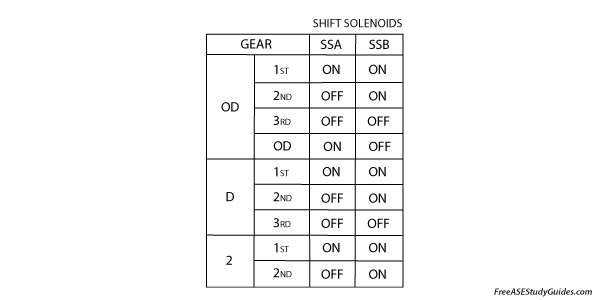ASE A2 Automatic Transmission Practice Test
16. Technician A says the valve body separator plate contains the seat for ball-type check valves. Technician B says ball-type check valves allow fluid flow in only one direction. Who is correct?
- A. Technician A
- B. Technician B
- C. Both A and B
- D. Neither A or B

17. A vehicle is not shifting into first gear and has no overdrive. View the chart above to determine which of the following is correct?
- A. Shift solenoid A is faulty.
- B. Shift solenoid A's circuit is compromised.
- C. Shift solenoid B is faulty.
- D. Both A and B are correct.
18. Which of the following is at the center of the planetary gear set?
- A. The pinion gear.
- B. The ring gear.
- C. The spur gear.
- D. The sun gear.
19. A vehicle with an automatic three-speed synchronous transmission slips when it shifts from first to second gear. Technician A says inaccurate timing in a synchronous transmission results in slipping and engine flare. Technician B says that early application of the intermediate band is causing this condition. Who is correct?
- A. Technician A
- B. Technician B
- C. Both A and B
- D. Neither A or B
20. Which of the following sensors affect the performance of the engine and the automatic transmission?
- A. The Manifold Absolute Pressure Sensor.
- B. The Mass Air Flow Sensor.
- C. The Throttle Position Sensor.
- D. All of the above.